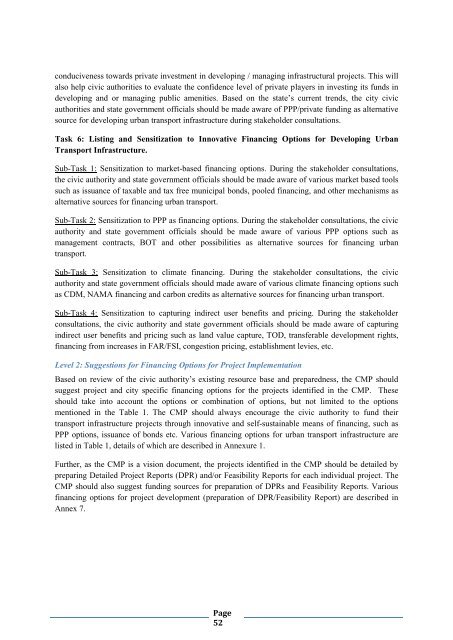Toolkits for Urban Transport Development - UNEP
Toolkits for Urban Transport Development - UNEP
Toolkits for Urban Transport Development - UNEP
You also want an ePaper? Increase the reach of your titles
YUMPU automatically turns print PDFs into web optimized ePapers that Google loves.
conduciveness towards private investment in developing / managing infrastructural projects. This will<br />
also help civic authorities to evaluate the confidence level of private players in investing its funds in<br />
developing and or managing public amenities. Based on the state’s current trends, the city civic<br />
authorities and state government officials should be made aware of PPP/private funding as alternative<br />
source <strong>for</strong> developing urban transport infrastructure during stakeholder consultations.<br />
Task 6: Listing and Sensitization to Innovative Financing Options <strong>for</strong> Developing <strong>Urban</strong><br />
<strong>Transport</strong> Infrastructure.<br />
Sub-Task 1: Sensitization to market-based financing options. During the stakeholder consultations,<br />
the civic authority and state government officials should be made aware of various market based tools<br />
such as issuance of taxable and tax free municipal bonds, pooled financing, and other mechanisms as<br />
alternative sources <strong>for</strong> financing urban transport.<br />
Sub-Task 2: Sensitization to PPP as financing options. During the stakeholder consultations, the civic<br />
authority and state government officials should be made aware of various PPP options such as<br />
management contracts, BOT and other possibilities as alternative sources <strong>for</strong> financing urban<br />
transport.<br />
Sub-Task 3: Sensitization to climate financing. During the stakeholder consultations, the civic<br />
authority and state government officials should made aware of various climate financing options such<br />
as CDM, NAMA financing and carbon credits as alternative sources <strong>for</strong> financing urban transport.<br />
Sub-Task 4: Sensitization to capturing indirect user benefits and pricing. During the stakeholder<br />
consultations, the civic authority and state government officials should be made aware of capturing<br />
indirect user benefits and pricing such as land value capture, TOD, transferable development rights,<br />
financing from increases in FAR/FSI, congestion pricing, establishment levies, etc.<br />
Level 2: Suggestions <strong>for</strong> Financing Options <strong>for</strong> Project Implementation<br />
Based on review of the civic authority’s existing resource base and preparedness, the CMP should<br />
suggest project and city specific financing options <strong>for</strong> the projects identified in the CMP. These<br />
should take into account the options or combination of options, but not limited to the options<br />
mentioned in the Table 1. The CMP should always encourage the civic authority to fund their<br />
transport infrastructure projects through innovative and self-sustainable means of financing, such as<br />
PPP options, issuance of bonds etc. Various financing options <strong>for</strong> urban transport infrastructure are<br />
listed in Table 1, details of which are described in Annexure 1.<br />
Further, as the CMP is a vision document, the projects identified in the CMP should be detailed by<br />
preparing Detailed Project Reports (DPR) and/or Feasibility Reports <strong>for</strong> each individual project. The<br />
CMP should also suggest funding sources <strong>for</strong> preparation of DPRs and Feasibility Reports. Various<br />
financing options <strong>for</strong> project development (preparation of DPR/Feasibility Report) are described in<br />
Annex 7.<br />
Page<br />
52
















